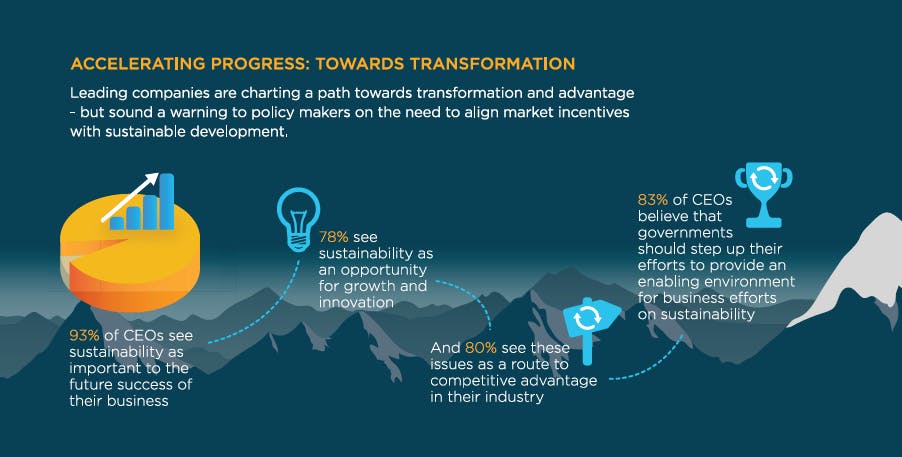The global economy is on the wrong track, and CEOs know that business is not yet playing its full part in forging a sustainable future. This is the striking finding from our recent in-depth study of more than 1,000 global CEOs’ attitudes to sustainability. The study holds lessons for businesses, of course, but also for municipal, city and national governments worldwide.
Of the business leaders surveyed in the latest triennial UN Global Compact-Accenture CEO Study on Sustainability, just 32 per cent believe that the global economy is on track to meet the demands of a growing population within global environmental and resource constraints, and over two-thirds admit business simply isn’t doing enough to address global sustainability challenges.
But sustainability is firmly on their agenda: 97 per cent of CEOs we interviewed believe that the management of sustainability issues will be critical to the future success of their business – even as they express a sense of “frustrated ambition” with the pace and scale of change on sustainability.
Besides internal initiatives – on energy efficiency, for example – CEOs believe that more is required to accelerate progress. They identify a need for greater ambition and better collaboration with consumers, investors and, importantly, policymakers, to enable business to uncover solutions to the world’s most pressing challenges.
“
The potential for transformation in Asia is formidable
The scale of the challenge in Asia
Asia is the world’s largest and most inefficient resource user: it requires three times as much energy input per earned dollar of GDP, and on its current trajectory is forecast to triple its carbon emissions by 2050. Furthermore, many Asian economies face a “trilemma” of challenges: rising affluence and consumption, growing resource scarcity and environmental pressures, and ongoing urbanization at a rapid pace. These conditions are characteristic of most emerging economies – but the sheer scale of the region commands attention: of the 10 largest countries by population, half are in Asia (China, India, Indonesia, Bangladesh and Japan). The potential for transformation in Asia is formidable.
The challenge of sustainable urbanisation, in particular, presents a compelling opportunity for leading companies to step up their efforts in driving competitive advantage through sustainability. As governments seek to improve the living standards of their citizens through cleaner growth and smarter infrastructure, the innovations of businesses will play a critical role.
Indeed, leading companies are already finding ways to turn sustainability to their advantage. We have been able to investigate links between CEOs’ attitudes and approaches to sustainability, and the financial and sustainability performance of their companies. Our analysis suggests that a two-speed world is emerging on sustainability, with a small group of “Transformational Leaders” beginning to drive business advantage through sustainability, moving beyond mitigation and incrementalism to harness sustainability as an opportunity for growth and differentiation.
So the good news is, leading companies are proving to investors and to regulators that there doesn’t have to be a trade-off between sustainability and business growth.
The seven steps to sustainability
At the heart of this new approach is a commitment to harnessing sustainability as an opportunity to drive value creation through new approaches to tackling global challenges, from environmental protection and energy provision to health, education and inequality. Transformational Leaders are not just approaching sustainability through the lens of mitigation and incremental improvement – but investing at scale in solutions directly targeted at sustainability challenges. In Asia, more than anywhere else, these investments yield returns that are immediate and close to home.
From our research, we see seven key themes emerging that are enabling these Transformational Leaders to achieve both value creation for their companies, and greater impact on global challenges.
1. Realism and Context
To harness sustainability as a force for transformation, organisations must first understand the scale of the challenge and the extent of the opportunities it presents.
Companies taking the most ambitious action on sustainability are also the most realistic: they are more likely to acknowledge that the world is not on track to meet the needs of a growing population – and admit that business is not doing enough. Understanding the challenge allows these companies to appreciate the opportunity for future growth in providing solutions to sustainability challenges, and to target strategies to achieve it.
Daiwa Securities, for example, one of Japan’s largest financial services companies, is an industry leader in the provision of socially responsible investment. Between 2008 and 2010 it launched eight impact investment bond products to enable both Japanese and overseas issuers to invest in sustainable initiatives in the fields of clean energy, microfinance, reconstruction, development, healthcare and education. Daiwa has handled US$4.6 billion in impact investment bonds since 2008.
“
Companies taking the most ambitious action on sustainability are also the most realistic: they are more likely to acknowledge that the world is not on track to meet the needs of a growing population – and admit that business is not doing enough
2. Growth and Differentiation
Rather than simply reacting to external expectations for sustainability strategies, Transformational Leaders view the urgency of sustainability issues as an opportunity to differentiate their products and services, and thereby access new markets and industries.
Leading European electronics firm Philips, for example, has invested in the development of a green product portfolio directly targeted at customers’ sustainability needs. These Green Products now represent more than half of the company’s total sales, compelling evidence that sustainability is acting as a spur to innovation and growth.
3. Value and Performance
From carbon emissions to water footprints, tracking environmental measures is now commonplace across industries.
For companies seeking to go beyond such incremental change, the challenge is twofold: not just to measure and manage metrics of reduction and mitigation, but also to quantify the value of sustainability to the company and to track their impact on the communities in which they operate.
Broadly, there are three ways a sustainability initiative can generate return to investors: it can contribute to revenue; it can contribute to the bottom line through things like cost reductions or greater employee productivity; or it can have intangible impact by boosting brand value, creating future demand or aiding competitiveness by reducing exposure to risk.
One example is Siemens’s valuation approach, which was specifically designed to target and measure the revenue generated by its environmental portfolio. So Siemens can tell you that in 2012, over 40 per cent of its revenue came from products that “play a central role in environmental and climate protection”.
4. Technology and Innovation
As ever-greater challenges demand ever-greater solutions, our data suggest that leading companies are turning to innovation and technology to provide the tools with which to address sustainability challenges and secure business advantage. From investment in renewables, to intelligent infrastructure enabled by machine-to-machine communications technology, to new closed-loop business models, leading companies are securing business advantage through innovative R&D and deployment of technologies ranging from industrial solutions to “smart” information communication technology such as cloud computing and analytics.
Communications technology company Ericsson, for example, is driving the transition to a low-carbon economy in Sweden through their leadership of the Smart Communication project in Stockholm Royal Seaport. Through innovation and smarter technology, the company is helping Stockholm reach its goal to be climate-positive by 2030 by mobilising a more connected city, focused on CO2 reduction and sustainable transport options.
5. Engagement and Dialogue
Business leaders are more conscious of the need to establish a constructive, two-way dialogue with consumers and local communities, regulators and policymakers, investors and shareholders, employees and labour unions. Rather than simply acting and then communicating, CEOs are actively engaging stakeholders to negotiate the role of their business in addressing global challenges. Mining companies, for example, recognise that engagement and dialogue with local communities is integral to success: with substantial investments over long time frames, leading companies in the sector are paying particular attention to actively negotiating their role in bringing employment and prosperity to local communities.

Image: Urban Solutions
6. Advocacy and Leadership
To ensure businesses can lead the way in defining and delivering new sustainability solutions, business leaders need to provide a blueprint for change. From developing new measures of success, to engaging with public policymakers and leading calls for free and open markets, business leaders’ advocacy and public commitment are integral to further progress. As Ramakrishnan Mukundan of Tata Chemicals told us, “There is no choice for businesses but to get on the road to sustainability: it is unsustainable to be unsustainable.” Dr Chuchottaworn Pailin of Thailand’s PTT Public Company Limited said: “We have a responsibility to bring our industry peers on-board and move together on sustainability initiatives in order to create the level of desired impact and raise awareness throughout society.”
7. Partnerships and Collaboration
In the context of intensifying pressures and flagging efforts, CEOs more readily acknowledge the role of collaboration and partnerships in meeting their ambitions on sustainability. Business can lead the way, they believe, and can maximise companies’ impact through close partnerships with governments, policymakers, industry peers, consumers and non-governmental organisations.
Global banking giant HSBC, for example, has embarked on its Water Programme, a five-year, US$100 million partnership with World Wide Fund for Nature (WWF), WaterAid and Earthwatch Institute. Working with WaterAid, the programme is reaching 1.1 million people with safe water and 1.9 million people with sanitation across Bangladesh, India, Nepal, Pakistan, Nigeria and Ghana. The impact of providing universal access to safe water and sanitation in the BRIC countries – Brazil, Russia, India and China – alone is predicted to generate annual economic benefits of US$125 billion, or 1% of their collective 2010 GDP, boosting the economic health of new markets critical to the bank’s future growth.
Pathways to Transformation: The Role for Governments
Through finding new ways to combine sustainability impact with business advantage today, leading companies are seizing an early advantage in the race to be the leaders of tomorrow. But there is of course, still a huge role for governments: at city and national level.
CEOs are demanding greater collaboration between business, governments and policymakers, according to our study: 42 per cent of respondents now list governments among their top three stakeholders in sustainability, a rise from 32 per cent in 2007. Meanwhile, 83 per cent of respondents think more efforts by governments to provide the enabling environment will be integral to the private sector’s ability to advance sustainability. Specifically, 85 per cent demand clearer policy and market signals to support green growth.
This will certainly be food for thought as this year’s WORLD CITIES SUMMIT gets underway, and we look forward to what further collaboration 2014 may bring.
Peter Lacy, managing director of Strategy and Sustainability Services for Accenture in the Asia-Pacific region, sits on the steering committee of the World Cities Summit Young Leaders selection committee. Ynse de Boer, managing director of Accenture’s Sustainability practice in Southeast Asia, has worked for over a decade with senior executives from a range of private and public sector organisations on sustainability, strategy and execution. This post originally appeared in in the Centre for Liveable Cities’ Urban Solutions.










